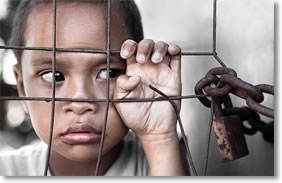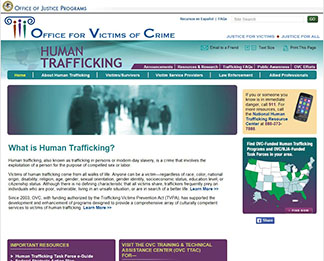Programs To Combat Human Trafficking
 OVC has had a longstanding commitment to supporting survivors of human trafficking and multidisciplinary task forces to combat this crime. OVC awarded the first federal grant to assist victims of trafficking in 1998. Two years later, the passage of the Trafficking Victims Protection Act of 2000 authorized funding for OVC to support victim service organizations to provide trauma-informed, culturally appropriate services for survivors of human trafficking. OVC intensified efforts in FYs 2013 and 2014 to strengthen the capacity of organizations that respond to the comprehensive needs of human trafficking survivors through:
OVC has had a longstanding commitment to supporting survivors of human trafficking and multidisciplinary task forces to combat this crime. OVC awarded the first federal grant to assist victims of trafficking in 1998. Two years later, the passage of the Trafficking Victims Protection Act of 2000 authorized funding for OVC to support victim service organizations to provide trauma-informed, culturally appropriate services for survivors of human trafficking. OVC intensified efforts in FYs 2013 and 2014 to strengthen the capacity of organizations that respond to the comprehensive needs of human trafficking survivors through:
- Enhanced Collaborative Model To Combat Human Trafficking
- Services for Victims of Human Trafficking
- Human Trafficking Strategic Action Plan
- Human Trafficking Task Force e-Guide
- Mobile-Friendly Human Trafficking Web Site
Enhanced Collaborative Model To Combat Human Trafficking
Since 2004, OVC and the Bureau of Justice Assistance (BJA) have partnered to establish multidisciplinary Anti-Human Trafficking Task Forces. In 2010, OVC and BJA began funding the Enhanced Collaborative Model to Combat Human Trafficking Victim Services, which uses a holistic approach to respond to human trafficking. The task forces are designed to identify victims of all types of human trafficking—including sex and labor trafficking, address the individualized needs of victims through quality services, and investigate and prosecute human trafficking cases at the federal, tribal, state, and local levels.
At each site, the program supports a state, local, or tribal law enforcement agency and a victim service provider. OVC awards support the provision of a comprehensive array of culturally and linguistically appropriate direct services to trafficking victims identified within the task force’s geographic area, while BJA awards support the coordinated efforts of local, state, federal, and tribal law enforcement to investigate and prosecute traffickers. During FY 2013, OVC provided nearly $6.5 million in funding to seven task force service providers in California, Washington, Missouri, Virginia, New York, and Texas. In FY 2014, OVC and BJA undertook an intensive analysis of the enhanced collaborative model and examined how well the funded task forces were operating. Based on both qualitative and quantitative analyses, program improvements were made, and a new solicitation incorporating these improvements was issued in FY 2015.
Services for Victims of Human Trafficking
In FY 2014, OVC awarded nearly $11.3 million in funding to 28 organizations through the Services for Victims of Human Trafficking Program, which awards funds to victim service providers to enhance the quality and quantity of services available to victims of human trafficking by enhancing interagency collaboration and a coordinated community response, and to provide high-quality services that address the individual needs of trafficking victims. These services include intensive case management, shelter and housing, food, medical and dental care, mental health treatment, support groups, interpretation and translation services, immigration and other legal assistance, literacy education, and job skills training. Through June 2014, OVC grantees provided services to 7,122 individuals identified as victims or potential victims of human trafficking.15
In FYs 2013 and 2014, funds were provided for Comprehensive Services, a full range of services that address the individualized needs of all victims—including U.S. citizens, legal permanent residents, and foreign nationals; adults and minors; males and females; and sex and labor trafficking victims—and for Specialized Services, direct services provided to subgroups of trafficking victims.
Human Trafficking Strategic Action Plan
In his remarks to the Clinton Global Initiative on September 25, 2012, President Obama pledged to “do even more to help victims recover and rebuild their lives. We’ll develop a new action plan to improve coordination across the Federal Government. We’re increasing access to services to help survivors become self-sufficient.”16 The first Federal Strategic Action Plan on Services for Victims of Human Trafficking in the United States 2013–2017 (SAP) fulfills that pledge and describes the steps that federal agencies will take to ensure that all victims of human trafficking in the United States are identified and have access to the services they need to recover and to rebuild their lives. The SAP focuses on providing and coordinating services for victims through 4 goals, 8 objectives, and more than 250 associated action items for victim services improvements that federal agencies will achieve by the end of 2017. OVC represented DOJ as one of the co-chairs in the development of the SAP, along with the Department of Health and Human Services’ Administration for Children and Families and the Department of Homeland Security’s Blue Campaign. The White House announced the formal release of the SAP on January 14, 2014, at a Survivor Forum and Listening Session hosted by OVC.
In FYs 2013 and 2014, OVC played a key leadership role on the Victim Services Committee of the Senior Policy Operating Group of the President’s Interagency Task Force to Monitor and Combat Trafficking in Persons. The Committee is helping to ensure collaboration and cooperation across federal agencies and helping to coordinate the SAP’s implementation, with the goal of identifying victims and providing them with appropriate services.
Human Trafficking Task Force e-Guide
OVC and BJA launched an expanded Human Trafficking Task Force e-Guide in 2014 to provide practical information on the creation and day-to-day operations of human trafficking task forces as well as essential knowledge needed to identify and assist victims effectively and to investigate and prosecute cases of human trafficking. The updated e-Guide—redesigned to make it easier for users to navigate the content and find information quickly—features new sections and strategies to strengthen multidisciplinary collaboration, increase victim identification, enhance victim-centered investigation, and build stronger prosecution strategies. Former Attorney General Eric H. Holder, Jr., has stated that the expanded e-Guide “gives law enforcement and victim service providers the information and insights they need to respond effectively to crimes involving forced sex and labor.”17
Mobile-Friendly Human Trafficking Web Site
 In 2014, OVC launched a new mobile-friendly human trafficking Web site that contains a wide range of information, including resources and research from the Federal Government, publications and products from OVC, local and national direct assistance information, and related funding opportunities for victims and survivors of human trafficking, victim service providers, law enforcement, and allied professionals. Human trafficking victim service providers and the public can access the Web site to learn about human trafficking; locate resources based on the specific types of services needed; watch, download, and share public service announcements; and read about OVC’s efforts to combat human trafficking. The Web site is most frequently accessed via mobile technology, and, consequently, is designed with tabs, layout, and readability for ease of use on wireless devices.
In 2014, OVC launched a new mobile-friendly human trafficking Web site that contains a wide range of information, including resources and research from the Federal Government, publications and products from OVC, local and national direct assistance information, and related funding opportunities for victims and survivors of human trafficking, victim service providers, law enforcement, and allied professionals. Human trafficking victim service providers and the public can access the Web site to learn about human trafficking; locate resources based on the specific types of services needed; watch, download, and share public service announcements; and read about OVC’s efforts to combat human trafficking. The Web site is most frequently accessed via mobile technology, and, consequently, is designed with tabs, layout, and readability for ease of use on wireless devices.








